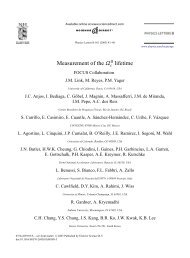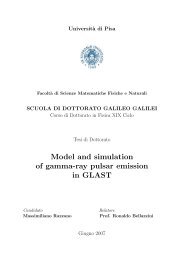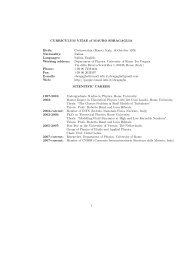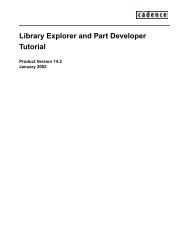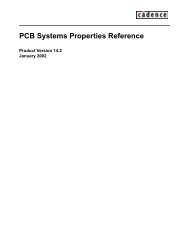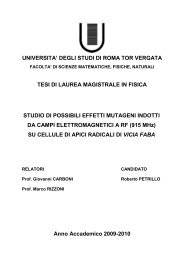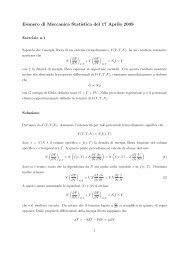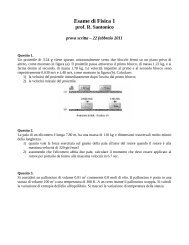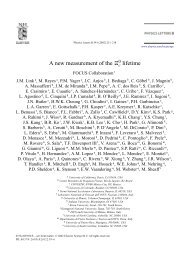Pamela - Infn
Pamela - Infn
Pamela - Infn
You also want an ePaper? Increase the reach of your titles
YUMPU automatically turns print PDFs into web optimized ePapers that Google loves.
Antiproton and Electron Measurements<br />
and Dark Matter Indirect Searches<br />
Piergiorgio Picozza<br />
INFN and University of Rome Tor Vergata<br />
8th International Workshop On Identification Of Dark Matter<br />
26-30 Jul 2010, Montpellier, France
Astrophysics and Cosmology<br />
compelling Issues<br />
• Apparent absence of<br />
cosmological Antimatter<br />
• Nature of the Dark Matter that<br />
pervades the Universe
Search for the existence of Antimatter in the Universe<br />
PAMELA AMS<br />
in Space<br />
<br />
Search for the existence of anti Universe<br />
Accelerators<br />
Search for the origin of the Universe<br />
The Big Bang origin of the Universe requires<br />
matter and antimatter<br />
to be equally abundant at the very hot beginning
THE UNIVERSE ENERGY BUDGET
Robert L. Golden
Balloon data : Positron fraction before 1990<br />
m χ =20GeV<br />
Tilka 89<br />
dinamic halo<br />
leaky box
ANTIMATTER<br />
Collision of High Energy<br />
Cosmic Rays with the<br />
Interstellar Gas<br />
Annihilation of<br />
Exotic Particles<br />
Cosmic Rays Leaking<br />
Out of Antimatter<br />
Galaxies<br />
Antimatter Lumps<br />
In the Milky<br />
Way<br />
e -<br />
Evaporation of<br />
p<br />
e +<br />
Primordial Black<br />
p<br />
e + Holes<br />
e +<br />
p<br />
p<br />
e +<br />
He<br />
e -<br />
e + e +<br />
Pulsar’s<br />
magnetospheres
Antimatter Direct research<br />
Observation of cosmic radiation hold out<br />
the possibility of directly observing a<br />
particle of antimatter which has escaped as<br />
a cosmic ray from a distant antigalaxy,<br />
traversed intergalactic space filled by<br />
turbulent magnetic field, entered the Milky<br />
Way against the galactic wind and found<br />
its way to the Earth.<br />
Streitmatter, , R. E., 24 th ICRC , Rome, , Italy, 1995<br />
Nuovo Cimento, 19, 835 (1996)<br />
High energy particle or antinuclei
•Kaluza-Klein DM in UED<br />
•Kaluza-Klein DM in RS<br />
•Axion<br />
•Axino<br />
•Gravitino<br />
•Photino<br />
•SM Neutrino<br />
•Sterile Neutrino<br />
•Sneutrino<br />
•Light DM<br />
•Little Higgs DM<br />
•Wimpzillas<br />
•Q-balls<br />
•Mirror Matter<br />
Dark Matter Candidates<br />
v( r)<br />
=<br />
GM(<br />
r)<br />
r<br />
•Champs (charged DM)<br />
•D-matter<br />
•Cryptons<br />
•Self-interacting<br />
•Superweakly interacting<br />
•Braneworld DM<br />
•Heavy neutrino<br />
•NEUTRALINO<br />
•Messenger States in GMSB<br />
L. Roszkowski<br />
•Branons<br />
•Chaplygin Gas<br />
•Split SUSY<br />
•Primordial ILIAS 6th Black Annual Holes Meeting , February 16th - 19st, 2009 Dresden Aldo Morselli, INFN Roma Tor Vergata 9
Another possible scenario:<br />
KK Dark Matter<br />
Lightest Kaluza-Klein Particle (LKP): B (1)<br />
Bosonic Dark Matter:<br />
fermionic final states<br />
no longer helicity<br />
suppressed.<br />
e+e - final states<br />
directly produced.<br />
As in the neutralino case<br />
there are 1-loop<br />
processes that produces<br />
monoenergetic<br />
in the final state.
DM annihilations<br />
DM particles are stable. They can annihilate in pairs.<br />
Primary annihilation<br />
channels Decay Final states<br />
a<br />
=
Positrons detection<br />
Where do positrons come from<br />
Mostly locally within 1 Kpc, due to the energy losses by<br />
Synchrotron Radiation and Inverse Compton scattering<br />
Typical lifetime<br />
Antiprotons within 10 Kpc
Decay Channels
e -
Antimatter Search<br />
Wizard Collaboration<br />
MASS – 1,2 (89,91)<br />
TrampSI (93)<br />
CAPRICE (94, 97, 98)<br />
BESS (93, 95, 97, 98, 2000)<br />
Heat (94, 95, 2000)<br />
IMAX (96)<br />
BESS LDF (2004, 2007)<br />
AMS-01 (1998)
Charge-dependent<br />
solar modulation<br />
Asaoka Y. Et al. 2002<br />
Cosmic Ray Antimatter<br />
Pre-PAMELA-Fermi status<br />
Solar polarity reversal<br />
1999/2000<br />
¯<br />
Antiprotons<br />
Positrons<br />
Moskalenko & Strong 1998<br />
Positron excess<br />
+<br />
CR + ISM → p-bar + …<br />
kinematic threshold:<br />
5.6 GeV for the reaction<br />
pp → pppp<br />
CR + ISM →π + x →μ + x → e +<br />
x<br />
CR + ISM →π 0 + x →γγ →e
What did we need<br />
• Measurements at higher energies<br />
• Better knowledge of background<br />
• High statistics<br />
• Continuous monitoring of solar modulation<br />
Long Duration Flights
Dark Matter<br />
Space Missions<br />
PAMELA<br />
15-06-2006<br />
ATIC<br />
2002 - 2007<br />
BESS<br />
12-2007<br />
AMS-02<br />
2010<br />
GLAST/Fermi<br />
11-6-2008
PAMELA<br />
Payload for Antimatter<br />
Matter<br />
Exploration<br />
and Light Nuclei Astrophysics
PAMELA<br />
Launch<br />
15/06/06<br />
16 Gigabytes trasmitted<br />
daily to Ground<br />
NTsOMZ Moscow
Orbit Characteristics<br />
SAA<br />
350 km<br />
70 ο 610 km<br />
• Low-earth elliptical orbit<br />
• 350 – 610 km<br />
• Quasi-polar (70 o inclination)<br />
• SAA crossed
Antiprotons
Antiproton flux<br />
•PAMELA
Antiproton to proton ratio<br />
•PAMELA
SAA<br />
Trapped pbar<br />
•PAMELA<br />
GCR<br />
• PAMELA
Positrons
Positron to all electron ratio<br />
Nature 458, 697, 2009<br />
PAMELA<br />
Secondary production<br />
Moskalenko & Strong 98
Positron Fraction<br />
Preliminary
Positron Fraction<br />
Pulsar Component<br />
Yüksel et al. 08<br />
KKDM (mass 300 GeV)<br />
Hooper & Profumo 07<br />
Pulsar Component<br />
Atoyan et al. 95<br />
Pulsar Component<br />
Zhang & Cheng 01<br />
Secondary production<br />
Moskalenko & Strong 98
A Challenging Puzzle for Dark Matter<br />
Interpretation
Data fitting<br />
Which DM spectra can fit the data<br />
DM with and dominant<br />
annihilation channel (possible candidate: Wino)<br />
positrons<br />
antiprotons<br />
Yes!<br />
No!
Data fitting<br />
DM with and dominant<br />
annihilation channel<br />
positrons<br />
antiprotons<br />
Yes!<br />
Yes!<br />
Yes!
Electrons
PAMELA Electron (e - ) Spectrum<br />
Preliminary Preliminary
PAMELA Electron (e - ) Spectrum<br />
Preliminary
PAMELA Electron (e - ) Spectrum<br />
Preliminary<br />
0.02
All electrons<br />
e + + e -
Courtesy Luca Baldini
All three ATIC flights are consistent<br />
Preliminary<br />
Preliminary<br />
ATIC 1+2+4<br />
ATIC 1<br />
ATIC 2<br />
ATIC 4<br />
“Source on/source off” significance of bump for ATIC1+2 is<br />
about 3.8 sigma<br />
J Chang et al. Nature 456, 362 (2008)<br />
ATIC-4 with 10 BGO layers has improved<br />
e , p separation. (~4x lower background)<br />
“Bump” is seen in all three flights.<br />
Significance for ATIC1+2+4 is 5.1 sigma
Example: DM I. Cholis et al. arXiv:0811.3641v1<br />
I. Cholis et al.<br />
arXiv:0811.3641v1<br />
See Neal Weiner’s talk
Fermi ( (e + + e - )
Electrons measured with H.E.S.S.
Fermi (e(<br />
+ + e - ) and PAMELA ratio<br />
Bergstrom et al. astro-ph<br />
0905.0333v1
Fermi (e(<br />
+ + e - )<br />
astro-ph 0912.3887
Fermi (e(<br />
+ + e - )<br />
astro-ph 0912.3887<br />
0<br />
=-2.7
PAMELA all electrons<br />
Preliminary
Gamma Constraints<br />
• γ from DM annihilation<br />
• γ from Inverse Compton on e ± in halo<br />
-upscatter of CMB, infrared and starlight photons on<br />
energetic e ±<br />
(Constraints on cosmological dark matter annihilation from the<br />
Fermi-LAT isotropic diffuse gamma-ray measurement)<br />
astro-ph. 1002.4415v1<br />
(Constraints on Dark Matter Annihilation in Clusters of<br />
Galaxies with the Fermi Large Area Telescope)<br />
astro-ph.1002.2239v1<br />
• radio-waves from synchrotron radiation of e ±
Astrophysical Explanation<br />
Pulsars<br />
S. Profumo Astro-ph<br />
0812-4457<br />
• Mechanism: : the spinning B of the pulsar strips e - that<br />
accelerated at the polar cap or at the outer gap emit γ that<br />
make production of e ± that are trapped in the cloud, further<br />
accelerated and later released at τ ~ 10 5 years.<br />
• Young (T ~10 5 years) ) and nearby (< 1kpc)<br />
• If not: too much diffusion, , low energy, too low flux.<br />
• Geminga: : 157 parsecs from Earth and 370,000 years old<br />
• B0656+14: 290 parsecs from Earth and 110,000 years old<br />
• Many others after Fermi/GLAST<br />
• Diffuse mature pulsars
Example: pulsars<br />
H. Yüksak et al., arXiv:0810.2784v2<br />
Contributions of e- & e+ from<br />
Geminga assuming different distance,<br />
age and energetic of the pulsar<br />
diffuse mature &nearby young pulsars<br />
Hooper, Blasi, and Serpico<br />
arXiv:0810.1527
Pulsars: Most significant contribution to high-energy CRE:<br />
Nearby (d < 1 kpc) and Mature (104 < T/yr < 106) Pulsars<br />
D. Grasso et al.<br />
• Example of fit to both Fermi and <strong>Pamela</strong> data with known<br />
(ATNF catalogue) nearby, mature pulsars and with a single,<br />
nominal choice for the e+/e- injection parameters
Anisotropy<br />
• Fermi is performing a detailed study<br />
of dipole anisotropy and it is setting<br />
an upper limit.
How reliable is the background calculation<br />
Secondary production<br />
Moskalenko & Strong 98
Cosmic Rays Propagation in the<br />
Galaxy
Antiproton to proton ratio
Proton and Helium fluxes
Proton to Helium ratio
ATIC
CREAM<br />
astro-ph/0808.1718<br />
= 0.33 top<br />
0.6 med.<br />
0.7 bot.
TRACER 2006<br />
Boron – Carbon Flux Ratio<br />
Preliminary Analysis<br />
- 70% Aperture<br />
- Conservative cuts<br />
Energy bin (10-300 GeV/amu)<br />
from analysis of DEDX<br />
detector only.<br />
- Boron 8,000 events<br />
- Carbon55,000 events<br />
Boron / Carbon Flux Ratio<br />
HEAO-3<br />
CRN<br />
TRACER 2006<br />
10 -1 1 10 10 2 10 3<br />
Increased statistics over<br />
CRN<br />
Expect several energy bins<br />
after energy deconvolution<br />
analysis<br />
10 -2<br />
Preliminary<br />
Analysis of events with<br />
transition radiation signal<br />
underway (ie > 400 GeV/amu)<br />
Kinetic Energy (GeV/amu)
Preliminary<br />
B/C
PAMELA preliminary results<br />
Li/C<br />
Be/C
Positron Fraction
Solar Modulation of galactic cosmic rays<br />
• Study of charge sign<br />
dependent effects<br />
Asaoka Y. et al. 2002, Phys. Rev.<br />
Lett. 88, 051101),<br />
Bieber, J.W., et al. Physi-cal<br />
Review Letters, 84, 674, 1999.<br />
J. Clem et al. 30th ICRC 2007<br />
U.W. Langner, M.S. Potgieter,<br />
Advances in Space Research<br />
34 (2004)<br />
<strong>Pamela</strong><br />
AMS-01<br />
Caprice / Mass /TS93<br />
BESS
Solar modulation<br />
Interstellar spectrum<br />
(statistical errors only)<br />
Increasing<br />
GCR flux<br />
July 2006<br />
August 2007<br />
February 2008<br />
Decreasing<br />
solar activity<br />
Ground neutron monitor<br />
PAMELA<br />
sun-spot number
Charge dependent solar modulation<br />
+<br />
¯<br />
+<br />
¯<br />
<strong>Pamela</strong><br />
2006<br />
(Preliminary!)<br />
A > 0<br />
A < 0<br />
Positive particles
BESS-Polar II Launch - December 22, 2007
BESS Detector<br />
–Rigidity measurement<br />
– SC Solenoid (L=1m, B=1T)<br />
– Min. material (4.7g/cm 2 )<br />
– Uniform field<br />
– Large acceptance<br />
–Central tracker<br />
– (Drift chamber<br />
– δ ~200μm<br />
– Z, m measurement<br />
– R,β --> m = ZeR 1/β<br />
2 -1<br />
– dE/dx --> Z<br />
TOF<br />
β, dE/dx<br />
JET/IDC<br />
Rigidity
BESS Polar II Observations/Expectations<br />
• Event rate ~2.5 kHz; Total events ~4.7 x 10 9<br />
• Total data volume 13.5 TB (3.07 kB/event)<br />
• Expected antiprotons ~10,000 10-20 times previous Solar minimum dataset<br />
Antiproton Antideuteron<br />
(Search for PBH) (Search for PBH)<br />
Antihelium<br />
(Search for Antimatter)
AMS-02 on ISS<br />
In Orbit 2010<br />
TRD<br />
Florida<br />
A&M<br />
Mexico<br />
MIT<br />
Yale<br />
Johns Hopkins<br />
Maryland<br />
ESA<br />
NIKHEF<br />
NLR, Amsterdam<br />
Annecy<br />
Grenoble<br />
Montpellier<br />
Ciemat-Madrid<br />
LIP-Lisbon<br />
ETH-Zurich<br />
Geneva Univ.<br />
Aarhus<br />
Kurchatov Inst.<br />
Inst. of Theor. & Experimental Physic s<br />
Helsinki<br />
Moscow State Univercity<br />
Turku<br />
Achen I & III<br />
Karlsruhe<br />
Munich<br />
Bologna<br />
Milano<br />
Perugia<br />
Pisa<br />
Roma<br />
Siena<br />
Bucharest<br />
IEE, IHEP<br />
Jiao Tong University<br />
Southeast University<br />
Korea<br />
IHEP<br />
Taiwan<br />
CSIST<br />
NCU<br />
Academia Sinic<br />
NSPO<br />
Vacuum<br />
Case<br />
Tracker<br />
MAGNET<br />
He Vessel<br />
RICH
The Completed AMS Detector on ISS<br />
Transition Radiation<br />
Detector (TRD)<br />
Time of Flight<br />
Detector (TOF)<br />
Silicon Tracker<br />
Magnet<br />
Electromagnetic<br />
Calorimeter (ECAL)<br />
Ring Image Cerenkov<br />
Counter (RICH)<br />
Size: 3m x 3m x 3m<br />
Weight: 7 tons
AMS-02<br />
new configuration
AMS Capability Space Part 2006<br />
Gamma Rays
Direct search for antimatter: AMS on ISS<br />
He<br />
Li<br />
Be<br />
B C<br />
Collect 2 billion nuclei<br />
with energies up to 2 trillion eV<br />
N<br />
O<br />
F Ne Na Mg Al Si<br />
P S Cl Ar K Ca<br />
Sc Ti VCr<br />
Mn<br />
Fe<br />
Co<br />
y06K301<br />
Atomic Number<br />
Sensitivity of AMS: If no antimatter is found => there is no<br />
antimatter to the edge of the observable universe (~ 1000 Mpc).
antiprotons<br />
Unique<br />
Feature<br />
of<br />
AMS<br />
positrons<br />
Combining searches in different channels could<br />
give (much) higher sensitiviy to SUSY DM signals<br />
gamma rays<br />
anti deuterons
The Next Future
Perspectives
Perspectives
Thanks!<br />
http:// pamela.roma2.infn.it



